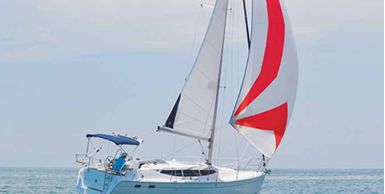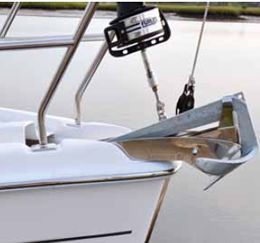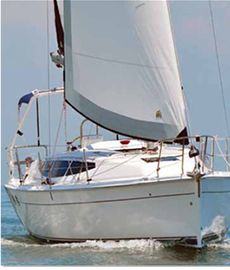
Photos courtesy of Hunter Marine
The new Hunter 33 had the odds stacked against it from the get-go.
The 33-foot family cruiser debuted in the fall of 2011, when the domestic sailboat market was stuck in a ditch, marketing budgets were slashed, and the U.S. boating industry was grasping at threads of good news. Four months later, Hunter Marine’s parent group Luhrs Marine filed for Chapter 11 bankruptcy protection.
Against all odds, however, the 33 is selling well. More than 60 have been ordered since the boat was introduced, and all but a few that have been built have been sold. It is one of Hunter’s best debuts since the 2008 downturn.
Looking ahead, the bankruptcy filing should be a boon for Hunter, as it will unshackle the sailboat side of the business from the struggling powerboat brands. Hunter, which converted to an employee-owned operation in 1996, expects to be out of the bankruptcy weeds by the end of July.

260
While new ownership appears in the offing for Hunter, co-founder Warren Luhrs will likely still have a stake. Luhrs—who’s 80-day sail from New York to San Francisco set a record in 1989—helped redefine Hunter in the 1990s. Under his leadership, design innovations by the late Swedish engineer Lars Bergstrom (the “B” in Hunter’s signature backstayless B&R rig) and faster hulls from designer Glen Henderson helped propel Hunter’s makeover through the last two decades.
“We have several very promising buyers interested, one in particular, but we can’t say anything right now,” said Greg Emerson, Hunter’s chief of public relations. The company has secured financing from Bank of America to help with the transition, allowing Hunter to continue full operations and provide warranty support without interruption.
Design
Of the big three American boatbuilders (Catalina and Beneteau USA are the other two), Hunter reached the farthest outside the box as the traditional boat market sagged. The hybrid powerboat-sailboat Hunter Edge introduced in 2009 was a sharp departure from its usual fare. In 2010, it launched the Elco-powered electric hybrid e27. And last year, Hunter debuted the electric hybrid e36. The new Hunter 33, by comparison, is a case study in incremental changes. Below the waterline, it is virtually identical to the previous Hunter 33, of which 623 hulls were between 2005 and 2011.
Starting in the mid-1990s, Henderson began revamping the Hunter fleet, exploring ways to boost performance, make sailing easier, and create interior space for the creature comforts that Hunter owners expect. The new 33 bears Henderson’s signature changes—beam carried well aft to increase interior volume below, a concave hollow in the bow and shallow forefoot to reduce pitching motion, and a fractional rig to make maneuvering under sail easier. Trickling down from the ocean racing realm, hard chines are the new trend in the recreational market. Henderson located the new 33’s chine at the waterline, to aid in tracking when the boat is heeled.
One of three designers we spoke with in Practical Sailor’s 2005 designers conference, Henderson emphasized the importance of the rudder in providing lift. Like previous Henderson designs, the 33’s elliptical rudder is fairly large, and the keel is conservatively proportioned, allowing sufficient lead—the fore-and-aft distance between the center of effort and the center of lateral resistance—to make for a well-balanced sailer. (See PS, February 2009, “The Balancing Act.”) Hunter offers a 4-foot-6-inch shoal-draft version and 5-foot-6-inch deep draft of the new 33.
The boat’s excitement factor will depend a great deal on the sail plan. Henderson is a firm proponent of the fractional rig, with an easily tacked 110-percent furling jib. To up the fun-factor in light-air, a Code 0 asymmetrical sail will be a good investment.
For the mainsail, Hunter offers two options. Most buyers opt for the in-mast furling rig, an attractive choice for weekend cruisers who don’t want the hassles of setting and stowing a mainsail. Performance enthusiasts should opt for the standard rig. A full-battened, fat-head mainsail will significantly boost horsepower: The mast is shorter (by nearly 5 feet), lighter, and more aerodynamic than the furling mast.
Foregoing a furling main has trade-offs. Hunter’s overhead arch puts the aft end of the sail high above the cockpit, making setting and dousing a full-batten sail more of a chore, particularly if a full bimini is part of the picture. To simplify stowage, Hunter offers a self-stowing sailcover system with lazy jacks similar to those we looked at in our February 2008 article “Taming the Main.”
On Deck
The clearest difference between the new 33 and the previous version is the new deck plan. The previous model had a walk-through transom that opened onto a stern boarding platform. The new model has a hinged transom cutout that folds down to create a swim platform that offers more area than the previous platform. As a result, the cockpit is larger, the main cabin can move aft, and the berth below the cockpit gains more space.
One big benefit of the larger cockpit, strictly from a cruising standpoint, is the bigger cockpit table. Featuring twin drop-down leaves hinged along the centerline, the 33’s table has a catch-all bin at its base—great for sunscreen, winch handles, and gloves—that doubles as a foot brace. There is plenty of room to move around the folded table, and older sailors will appreciate the extra handhold.
The previous model’s more secure—and unattractive, in our view—bathtub wrap-around coaming is gone. Instead, port and starboard lockers (starboard for propane tanks) are aft. The cockpit seats are technically too short for snoozing (4 feet, 9 inches by 1 foot, 6 inches), but seat cushions raise the seats up to the same level of the lazarettes, so you effectively have 5 feet, 7 inches to stretch out. Head clearance under the arch is 6 feet. A 4-inch bridgedeck keeps water from sloshing below. Lexan hatchboards stow in a dedicated storage bin in the port cockpit locker, ready as needed offshore.
Our test boat from Massey Marine in Palmetto, Fla., was equipped with the Mariner Package, which includes the overhead arch, an upgraded 29-horsepower Yanmar, Seldén in-mast mainsail furling with a rigid boom vang, a helm sheeting package for the jib, and the optional folding Lewmar steering wheel. It also had upgraded No. 30 Lewmar winches for reefing and furling lines; No. 16 winches are standard. A high-aspect canvas dodger and full-length cockpit canvas rounded out the package.
Sail control is easily managed from the cockpit. Halyards, reefing, and furling lines lead back to ganged Spinlock rope clutches at each side of the companionway. Molded line bins keep tails and toes from becoming ensnared. Mainsail control—both the traveler and mainsheet—can be reached from the helm, although the test boat’s full canvas awning made it hard to monitor the sheet tension and traveler car position, even with a cutout window over the helm. While mid-boom sheeting found on other boats doesn’t suffer this problem, Hunter sensibly prefers end-of-boom sheeting, which minimizes the loads on hardware and humans.
The 19-inch-high coaming offers security in a knock-down, but makes for a big step down to the sidedecks. While hardly expansive, the sidedecks allow easy passage fore and aft. Ample handholds and a low toerail offer security when moving forward. A reconfigured rig, with lower shrouds well inboard, also opens up the passage forward.
Six amply sized cleats (two at the bow, one on each stern quarter, and two amidship) handle docklines, but the stern cleats are vertically oriented, making them harder to access and poorly aligned with dock loads.
The self-draining anchor locker, single bow roller (two rollers are an option), and windlass gear meet the needs of a weekend sailor. This is a standard design on boats of this size, geared more toward aesthetics than midnight anchor drills on a pitching deck. (The more sensible hawse pipe is too much trouble for today’s sailors, it seems.) The anchor locker is relatively shallow, a poor match for someone who likes to pile on rode or carry two anchors. A locker divider is optional.
Most of the sailing hardware is Seldén gear, and this equipment has done very well in our previous tests. Seldén’s 200s Furlex, top rated in our August 2009 test, handles jib furling duties. Seldén’s in-mast furler and rigid vang help tame the mainsail, and Seldén’s top-rated bullet blocks (PS, June 2011) handle mainsheet loads. This is Hunter’s first big boat to feature Seldén’s mainsheet traveler.
Systems
The new 33 is the first Hunter model with a saildrive. The standard engine is the 21-horsepower Yanmar 3YM20, but our test boat featured the 29-horsepower 3YM30, which has a shaft output of 27 horsepower. The engine is mounted with the flywheel facing aft, so the gearbox and saildrive mounts and seals are easy to inspect and monitor. Access to the water pump, alternator, and drive belts is through a door in the aft cabin.
Yanmar recommends that this engine be hauled out, inspected, and serviced annually. Paint failure and corrosion on the aluminum lower unit are the chief concerns, so zincs need to be changed routinely, and the paint coating needs to be closely monitored. Copper-loaded bottom paints on the drive are a big no-no. If you live in a tropical climate and are trying to stretch your haulout intervals to three years, you may want to re-think the advantages of having a saildrive.
Saildrives simplify the builder’s job, and their only real advantages for the sailer are reduced underwater drag and some noise reduction. The standard prop is a bronze two-blade prop. Our test boat came with a folding two-blade prop. For long-term reliability and fewer maintenance headaches, we still prefer a conventional drive shaft system.
The boat’s standard systems are handled professionally and are adequate for daysailing, but most sailors will opt for a cruise-ready package, which includes some things we’d consider essential. There is also an iTech upgrade featuring additional HDMI and USB cabling and a cell-phone booster antenna for those who want to stay connected.
Bronze through-hulls have replaced the Marelon versions used on previous models. All seacocks are easily accessible and well labeled. Wiring and plumbing systems closely adhere to norms set by the American Boat and Yacht Council. The 25-gallon fuel tank is polyethylene. We prefer high-grade aluminum for fuel (PS, May 2007). The tank is well supported on all sides and small enough that the rotomolded tank’s biggest drawback—the difficulty of installing leak-free inspection ports—isn’t a major issue.
Interior
Hunter’s interior arrangements are among its strongest selling points. The computer-cut interior panels are assembled in modules outside the boat, significantly reducing labor cost. Joints, doors, and lockers that require skilled carpentry are pre-built and fitted in the workshop, where they can get the attention they deserve.
You won’t find finished edges on all plywood panels, but the warm cherry veneer, the creative use of space, and a few practical touches create an interior that is surprisingly roomy and comfortable for a boat of this size.
The extra space gained by pushing the cockpit aft allowed Hunter to angle the steps inboard, so one can walk down facing forward, with excellent handholds on either side of the companionway.
Headroom is 6 feet, 2 inches. White foam-backed material covers the overhead and sides. The material is held in place by grooved plastic track and can be removed and re-installed (with a special roller) to access deck hardware. This allows Hunter to through-bolt all hardware through a backing plate.
The main cabin and galley are well lit with big side windows, and two flush, frameless overhead hatches—one opening forward, the other opening aft—provide ventilation. The forward V-berth has its own hatch, and the aft cabin in the starboard quarter has a larger-than-queen-size bed, two ports and a fairly large hatch in the port settee. These hatches don’t get a whole lot of breeze in a still anchorage, but the space is much airier than that of previous models.
The galley is well-appointed, with a gimbaled, two-burner Force 10 stove and oven, and a single, deep sink. So long as you don’t need access to lockers or the ice-box (or optional freezer), there’s more than enough counter-space. Our test boat had a minimally insulated, front-opening fridge. These self-contained units work well for daysailing and dockside entertaining, but can be real energy hogs away from shore. A top-loading freezer/fridge with better insulation is an option.
The starboard head doubles as a shower, which has its own sump. The space’s snug fore-and-aft dimensions allow for a sleeping-length settee to starboard and the spacious aft cabin.
The dinette table has a slightly raised, fiddled catch-all for food, drinks, iPods, Barbie dolls, Legos, whatever. Beneath the vertical structure is a hand crank that raises and lowers the table, quickly converting it into a long 4-foot-4-inch-wide berth. This is a slick, one-person operation. Similarly, the center section of the starboard settee flips inboard to convert into a coffee table or small chart table.

Photo courtesy of Hunter Marine
230
Performance
We tested the boat in protected waters on the Bradenton River, Fla., in 10 to 12 knots northwest wind. A quarter-knot incoming tide was nearly aligned with the wind, and the following data, recorded by the GPS on our Velocitek ProStart, compensates for this current.
At 2,600 rpm, the upgraded 29-horsepower engine with a 13-inch, two-bladed folding Gori prop pushed the boat at 6.5 knots. At wide-open throttle, 3,400 rpm, the average speed was 7.3 knots and the wake was clean. The boat easily spun 180 degrees in little more than a single boat length, and it maneuvered easily under power in both forward and reverse. The engine was quiet with very little vibration at either speed, only slightly noisier at the higher rpm, registering 77 decibels in the center of the main saloon and in the cockpit with the companionway open. (Conversation is about 60-70 decibels.)
Even with shoal-draft and an in-mast furling mainsail that had no vertical battens, the test boat climbed to windward well; we would expect much better performance with the deep keel version and the standard mainsail.
Tacking angles were between 90 and 94 degrees. Close-reaching with the wind 45 degrees true and a relative windspeed of 14 knots, the boat made 4.9 knots over ground. Cracking off to 50 degrees true wind angle, the speed jumped to 6.4 knots. The fastest sustained speed was 6.5 knots at 70 degrees true, in 14 knots apparent wind.
Reaching between 130 and 160 degrees off the wind, the boat averaged between 5 and 5.5 knots. Apparent windspeed off the wind was between 6 and 8 knots, perfect conditions for an asymmetrical, although our test boat was not equipped with one. Throughout the test sail, the helm was exceptionally well balanced, even off the wind, and the boat accelerated nicely in puffs.
Conclusion
For a new, entry-level family cruiser, the Hunter 33 has a lot going for it. The $160,000 sailaway price is attractive; the five-year warranty on the hull is transferrable. A one-year stem-to-stern warranty covers major components, including things like refrigerators and windlasses.
Our tester was impressed by the excellent use of space in a boat of this size, both belowdecks and in the cockpit. In this respect, it is a big improvement over the previous Hunter 33.
Second was its performance on the water. Even with a battenless mainsail, this was a fun boat to sail. We’d encourage a stickler for performance to opt for the full-batten main.
Two concerns, in our view, are the standard iron keel and the sail drive, but you can’t expect a company like Hunter, for which pricing is a key sales point, to fight against market trends. A lead keel is an option for the Hunter 33, and is well worth the extra $9,800, in our view.
If you are having the boat hauled annually to ensure that the keel coating remains intact and the sail drive maintenance regimen is followed, you will avoid the problems that can crop up down the road. Certainly, around-the-can racing sailors will appreciate the reduced drag of the sail drive.
Hunter has had many years to learn what its customers like, and the variety of options in this boat will appeal to a wide range of sailors. We expect it to continue to sell well in this size range, and consider it a good fit for a coastal cruising family.

































